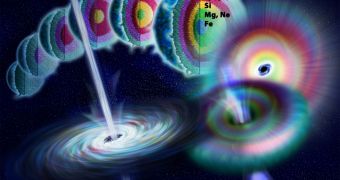A recent investigation by scientists with the College of Charleston in South Carolina has revealed the largest known structure in the Universe. Though this is a significant finding by itself, the work also highlighted some discrepancies between theory and real life when it comes to describing the early stages of the Cosmos.
One of the most important principles in modern astrophysics is that matter should theoretically appear to be distributed uniformly, when viewed at massive scales. As expected of a study focused on the largest structure in the Universe, scientists looked for signs of such distribution, but found none.
In fact, the extremely distant formation, measuring an estimated 10 billion light-years in diameter, could have only formed through a massive accumulation of material in a certain portion of the early Universe. Astrophysicists will now have to find a way of explaining this interesting result.
According to early measurements of the newly found formation, it is nearly twice as large as the Large Quasar Group (Huge-LQG), which measures 4 billion light-years in diameter. The Huge-LQG is itself nearly six times larger than the Sloan Great Wall, which was the largest known structure in the Universe at one point.
The research group was able to infer the existence of the huge formation following an analysis of multiple gamma ray bursts (GRB), which are among the most energetic events that can occur. These blasts send massive volumes of gamma-rays (the most energetic type of light) into space.
Most often, GRB are produced by exploding stars, but they can also originate in black hole or neutron star mergers and in other high-energy events. Scientists led by astronomers Jon Hakkila used these fleeting radiation bursts to trace back the origins of their parent stars.
After investigating a consistent number of GRB, the team determined that a huge cosmic structure lies in the direction of the constellations Hercules and Corona Borealis, and that the formation measures no less than 10 billion light-years in diameter.
“This is probably a large concentration of galaxy clusters and other normal matter,” explains Istvan Horvath, a co-investigator on the study and a professor at the National University of Public Service, in Budapest, as quoted by Discovery News. The work is detailed online in the journal arXiv.

 14 DAY TRIAL //
14 DAY TRIAL //